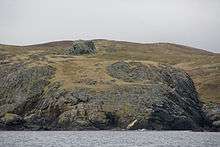Lunna Ness
Lunna Ness is a peninsula in the north east of Mainland, Shetland, Scotland , in the parish of Lunnasting near Vidlin. The island of Lunna Holm is nearby. The Shetland Bus operation during World War II used this area as a base.[1]

The Stanes of Stofast is a 2,000 tonne glacial erratic that came to rest on a prominent hilltop.[2]
The Lunnasting stone is a monolith bearing an ogham inscription discovered in the area and donated to the National Museum of Antiquities of Scotland in 1876. It was found by Rev. J.C. Roger in a cottage, who stated that the stone had been unearthed from a "moss" (i.e. a peat bog) in April 1876, having been originally discovered five feet (1.5 m) below the surface.[3]
Lunna Ness is a Site of Special Scientific Interest based on the abundance of the otter population.[1]
Lunna House is a 17th-century laird's house, noted for having "the best historic designed landscape in Shetland".[4] In the 20th century it was used as a base of the wartime Shetland Bus operation.
Notes
- "Delting, Lunnasting & Nesting". Visit Shetland.org. Retrieved 3 April 2011.
- Schei (2006) pp. 103-04
- "LTING/1" University College London, quoting Forsyth, K. (1996) "The Ogham Inscriptions of Scotland: An Edited Corpus". Unpublished PhD. Harvard University. Retrieved 12 July 2009.
- Historic Environment Scotland. "LUNNASTING, LUNNA, LUNNA HOUSE, INCLUDING GARDEN AND RETAINING WALLS... (Category B) (LB18591)". Retrieved 14 March 2019.
References
- Schei, Liv Kjørsvik (2006) The Shetland Isles. Grantown-on-Spey. Colin Baxter Photography. ISBN 978-1-84107-330-9